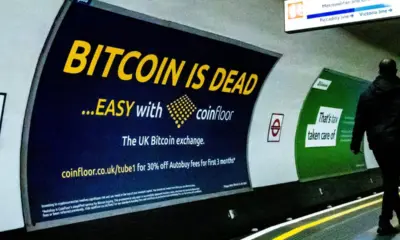Technology
London Tube commuters use stablecoins for vending machines pilot crashes
Introduction
The London Underground has always been a testing ground for quirky innovations, from contactless payments to mobile apps that tell you exactly which carriage to board. But the latest experiment has left commuters and crypto enthusiasts equally baffled. Transport for London quietly launched a pilot program allowing passengers to purchase snacks and drinks from vending machines using stablecoins. Within days, the initiative descended into chaos as technical glitches, wallet errors, and a lack of crypto know-how among everyday commuters turned the pilot into a citywide joke.
The launch of the pilot
The vending machines chosen for the project were strategically placed in busy stations such as Oxford Circus, Waterloo, and King’s Cross. Each machine was outfitted with a digital display offering passengers the option to pay in fiat or with a euro-pegged stablecoin via QR code. The vision was simple: bring blockchain into everyday life by turning the humble chocolate bar purchase into a futuristic financial experience.
Officials described the project as an opportunity to modernize urban payments and attract younger commuters already familiar with crypto. The plan was ambitious but straightforward. Passengers would scan a QR code, transfer stablecoins from their wallet, and immediately receive their snack with a blockchain receipt confirming the transaction.
First signs of trouble
From day one, problems began to surface. Commuters unfamiliar with digital wallets struggled to even access the payment option. Long queues formed in front of vending machines as confused passengers attempted to download apps or remember seed phrases. Some who managed to scan the QR code reported waiting several minutes for their transactions to process, only for the machine to display an error message. Others complained that the machines deducted the stablecoins but never released the snack.
The situation worsened during rush hours when stations were already crowded. A vending machine jammed by crypto-related delays was the last thing commuters wanted as they sprinted to make their trains. Social media quickly filled with photos of angry crowds around machines and jokes about passengers paying ten stablecoins for a bottle of water that never appeared.
Public reaction and memes
As with any London transport fiasco, humor became the main outlet. Twitter, TikTok, and Instagram were flooded with memes mocking the experiment. One viral video showed a commuter shouting at a machine while the caption read, “My wallet just bought three KitKats but I got none.” Another joked that the machines were secretly running stress tests for the Bank of England’s digital currency project.
Crypto enthusiasts tried to defend the pilot, arguing that technical glitches were normal in early adoption phases. However, skeptics seized the opportunity to highlight the impracticality of using blockchain for small everyday purchases. A leading tabloid declared the scheme “the most expensive bag of crisps in Britain,” a line that stuck in memes and headlines for the rest of the week.
Behind the scenes confusion
Internal reports later revealed that the vending machines had not been adequately tested under real-world conditions. WiFi connections inside deep Underground stations were unreliable, causing delays in blockchain confirmations. Moreover, the stablecoin provider used for the pilot had experienced network congestion, further complicating transactions.
Transport officials admitted that they underestimated the learning curve required for everyday commuters. While younger crypto-savvy users were able to manage payments, most passengers had little interest in downloading wallets or understanding how to convert fiat into stablecoins for a snack. Staff working in stations were not trained to handle questions, leaving frustrated customers with no guidance.
Financial and reputational fallout
The failed pilot has sparked debates over the role of crypto in public services. On one hand, the project demonstrated a willingness to experiment with cutting-edge technology. On the other, it revealed how ill-suited blockchain can be for micropayments in high-traffic environments.
Critics argue that Transport for London wasted money on a gimmick rather than focusing on improving basic services like escalators and ticket machines. Some politicians have called for an audit of the project’s costs, while others see the fiasco as evidence that crypto adoption should remain in private markets rather than public infrastructure.
Meanwhile, the stablecoin provider involved has defended the project, claiming that glitches were due to poor planning rather than flaws in the technology itself. They insist that with stronger network infrastructure and better consumer education, similar initiatives could succeed in the future.
Wider context of crypto adoption
The vending machine chaos comes at a time when London is positioning itself as a hub for digital finance. The UK government has repeatedly spoken of embracing innovation, from crypto regulation to exploring central bank digital currencies. However, the pilot highlights the gulf between policy ambitions and everyday usability.
Other European cities have experimented with blockchain payments, often in niche contexts such as stadium concessions or limited public events. Few have tried implementing them in high-pressure commuter environments where speed and reliability are non-negotiable. London’s attempt may now serve as a cautionary tale for other cities considering similar experiments.
What comes next
Transport for London has already suspended the pilot, promising a full review. Officials suggest that the concept may return in a revised form, possibly at surface-level locations with stronger internet connections or as part of promotional tie-ins with crypto sponsors. Some propose limiting blockchain payments to non-essential items, such as collectibles or special edition merchandise, rather than everyday snacks.
The incident also raises broader questions about how crypto can realistically integrate into daily life. While fans of digital assets argue that mass adoption is inevitable, the vending machine experiment demonstrates that practical hurdles remain. Convenience, speed, and user-friendliness are critical, and in this case, blockchain fell short on all three counts.
Conclusion
The attempt to bring stablecoin payments to London Tube vending machines was ambitious, creative, and ultimately disastrous. Instead of showcasing blockchain as a seamless part of urban life, it exposed the difficulties of merging complex digital systems with the fast-paced demands of public transport. What was meant to be a demonstration of modern finance became a comedy of errors, immortalized in memes and tabloid headlines.
While the pilot may be remembered as a failure, it also serves as a valuable lesson for both the crypto industry and public institutions. Innovation requires not just technology but planning, education, and infrastructure. Until those pieces align, the dream of buying crisps with stablecoins in the Underground will remain more meme than reality.



















